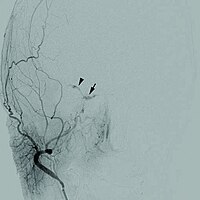
Photo from wikipedia
BackgroundAlagille syndrome is a pediatric multisystem disease with increased prevalence of cerebrovascular disease. The spectrum of cerebrovascular disease in Alagille syndrome includes cerebral aneurysms, moyamoya arteriopathy and dolichoectasia. The prevalence… Click to show full abstract
BackgroundAlagille syndrome is a pediatric multisystem disease with increased prevalence of cerebrovascular disease. The spectrum of cerebrovascular disease in Alagille syndrome includes cerebral aneurysms, moyamoya arteriopathy and dolichoectasia. The prevalence of cerebrovascular disease in Alagille syndrome varies widely in the literature.ObjectiveTo determine the prevalence of cerebrovascular disease in our institution’s Alagille patient population by employing a full primary review of all available neuroimaging.Materials and methodsAn institutional review board-approved retrospective review of all Alagille syndrome patients seen at a tertiary care children’s hospital from January 2000 to January 2014 was performed. All neuroimaging studies were reviewed for arterial or venous abnormalities. The prevalence of arterial and venous abnormalities was calculated and clinical outcomes were determined.ResultsFifty-two patients with Alagille syndrome ranging in age from 11 months to 27 years were studied. Nineteen (37%) had dedicated vascular neuroimaging. Six (32%) had cerebral arterial disease, 4 with dolichoectasia, 3 with aneurysm(s) and 2 with moyamoya arteriopathy. Three of the four patients with dolichoectasia had associated aneurysm(s). Venous anomalies were present in 4 (21%) patients. One patient with moyamoya arteriopathy underwent revascularization procedures. No deaths were attributable to cerebrovascular disease.ConclusionCerebral vasculopathy is an important feature of Alagille syndrome and includes dolichoectasia, cerebral aneurysms and moyamoya arteriopathy. The high prevalence identified in our study suggests noninvasive vascular neuroimaging screening should be performed in this patient population. In addition to cerebral arterial abnormalities, alterations of venous development may be a feature of Alagille syndrome.
Journal Title: Pediatric Radiology
Year Published: 2017
Link to full text (if available)
Share on Social Media: Sign Up to like & get
recommendations!